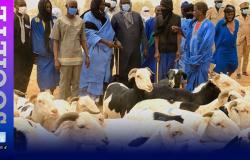While Senegal has made significant progress in the development of its market gardening production, in particular in the onion and potato sectors, the sector is today faced with structural overproduction. This paradox – produce more but sell less – highlights the limits of unlanned growth, poorly attached to real outlets and still insufficient logistics. A sustainable response requires strategic regulation and better integration of agriculture into industry.
In 2025, the national onion production reached 450,000 tonnes, a historic record, compared to 412,000 tonnes in 2024 and only 210,000 tonnes in 2023. This rapid progression made it possible to largely cover the needs of the country, estimated at around 350,000 tonnes, generating a surplus of 100,000 tonnes. In response, the government has suspended imports of onions from January 25, 2025.
The same trend is observed for the potato. In 2025, production reached 240,000 tonnes, while consumption needs vary between 130,000 and 150,000 tonnes, an excess of 90,000 to 110,000 tonnes. Again, the state has decided to suspend imports, focusing on local transformation and storage to enhance this surplus.
In the past, Senegal flowed part of its surpluses on the Mauritanian market. This outlet has shrunk for the benefit of Morocco, which, thanks to higher agricultural yields and an efficient logistics, has managed to impose itself on these markets. Morocco has a comparative advantage: its production costs are lower, and its much more developed conservation and export infrastructures.
Faced with this situation, natural regulation will take place: some producers will consider abandoning the onion and the potato in favor of other speculations. But this development risks being disorderly and could weaken the income of small producers.
Regulate by incentive, structure by logistics
It is imperative that the State accompanies this transition by active and anticipatory regulation. This implies acting at three levels: incentive planning of production, the development of conservation and processing logistics, and a better organization of marketing circuits.
A strategic opportunity lies in the agro-climatic diversity of the territory. For example, the Niayes and the Senegal River valley do not have the same cultural calendars. It is therefore possible to stall the periods of harvest in a complementary manner, in order to spread the arrivals on the markets and to avoid seasonal or cyclical overproductions.
Conservation and storage: a strategic link but not a panacea
Conservation is often perceived as an immediate response to overproduction. But it is important to recall two essential things:
- Conservation is not a sufficient solution if the problem of price competitiveness and outlets is not resolved. Infrastructure can be built but remain underused if the stored products do not find takers at a good price.
- Conservation begins upstream: it is not limited to equipment downstream from the sector. It also involves the choice of adapted seeds, the use of appropriate inputs, and cultivation techniques that optimize the lifespan of products after harvest.
Three levers for a sustainable exit from the crisis
To leave this dead end, three axes are priority:
- Craft and industrial transformation
One of the most promising tracks is to locally enhance the surpluses through simple, unclear and job creative transformation activities. Several international experiences can inspire Senegal:
-– In India, surplus onions are transformed into flakes or powder by cooperatives.
– In Kenya, SMEs manufacture precious potato chips and fries.
– In Tunisia, female groups transform the onions into ready -to -use dough.
– In Bangladesh, onion or potato pickles are marketed locally or exported.
– In Peru, the potato is transformed into dried flakes or flour (Papa SECA).
These examples show that it is possible to create transformation micro-units in excess areas such as Niayes or the River Valley. This would reduce post-harvest losses and stimulate local consumption.
- Targeted export
It is necessary to diversify external outlets, to better integrate quality standards and reinvest the lost markets, especially in West Africa and with diasporas.
- Controlled intensification
Producing more is not in itself problematic, provided you do it more efficiently: with less losses, improved quality and competitive costs. This intensification must be based on the grouping of small producers within cooperatives capable of pooling equipment (tractors, boreholes, cold rooms) and benefiting from structured technical support. However, it is precisely this public supervision that is lacking today in the market gardener, limiting productivity gains and the sustainability of the efforts made.
Conclusion-Agriculture-Industry integration: essential link in a value chain
Senegal has young, abundant human capital engaged in agriculture. This considerable potential remains, however, restricted by a lack of equipment, insufficient logistics infrastructure and, above all, the absence of real articulation with industry. To have a long -term overproduction and waste cycles, agriculture can no longer remain an isolated sector. It must become the base of an integrated ecosystem, where agrifood transformation, distribution and export are thought together, in a logic of coherent and competitive value chain.
Amath Ndiaye Faseg-Ucad








